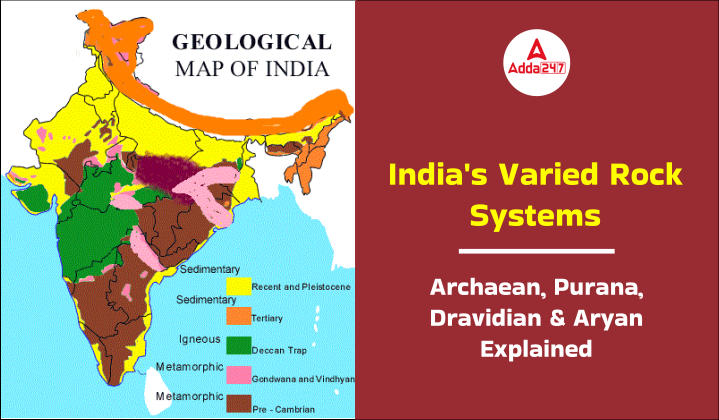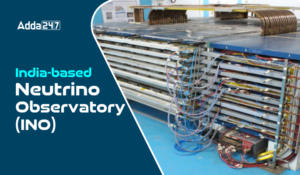Table of Contents
The subcontinent’s geological past can be derived from the dynamic and complex process of classifying India’s rock system. Every one of the numerous rock formations that adorn India’s varied terrain-which stretches from the high Himalayas to the enormous Deccan Plateau—tells a unique tale of sedimentation, tectonic activity, and metamorphism over millions of years.
Through a more thorough understanding of India’s natural resources, environmental landscapes, and seismic dangers, geologists and researchers can better comprehend the complex details of the country’s geological past according to this classification.
This categorization framework provides a platform for researching the geological development of India and revealing the mysteries concealed underneath its rocks by systematically classifying them according to their age, composition, and place of origin.
The Indian Rock System
India is a geological entity made up of several rock systems that date back several ages and periods. India’s rock system system is divided into the following four categories:
- The Archaean Rock System
- The Purana Rock System
- The Dravidian Rock System
- The Aryans Rock System
Archaean Rock System
The Archaean Rock System, representing one of the oldest rock systems in the world, is characterized by distinctive features and holds significant geological and economic importance:
Period of Formation: Formed approximately 4 billion years ago during the cooling and solidification of molten magma in the Earth’s upper crust, the Archaean rocks mark an ancient era in our planet’s geological history.
Features:
- Azoic (unfossiliferous): Lack of fossils due to the absence of complex life forms during that ancient time.
- Crystalline (because of volcanic origin): Displaying a crystalline appearance due to their volcanic origin, resulting from the solidification of molten magma.
- Foliated (consisting of thin sheets): Exhibiting foliation, which arises from the alignment of mineral grains under pressure, giving rise to a layered or sheet-like structure.
- Extremely contorted and faulted: Often showing intense deformation, including folding, faulting, and metamorphism, indicating significant tectonic activity during their formation.
- Often formed as plutonic intrusions (volcanic rocks found deep inside): Many of these rocks originate from plutonic intrusions, which are volcanic rocks that solidify deep beneath the Earth’s surface.
Major Rocks: It consists of Gneiss which covers a significant portion of peninsular India, displaying a range of mineral compositions from granite to gabbro. They often possess foliated or banded structures and Schists which are a prominent component of the Archaean system.
Location: Archaean rocks are found in various regions, including:
- The Himalayas
- Central and southern parts of the Indian Peninsula
- States such as Orissa, Meghalaya, Madhya Pradesh, Chhattisgarh, and the Chotanagpur Plateau of Jharkhand
- Bundelkhand region
Significance: These rocks are economically significant due to their mineral resources, including mica, talc, hornblende, chlorite, and other valuable minerals. These resources contribute to various industrial applications, such as ceramics, paints, electrical components, and more, thereby playing a crucial role in regional and national economies.
Dharwar Rock System
The Dharwar System, named after the Dharwar district of Karnataka, represents a significant geological formation with distinct characteristics and economic importance:
Period of Formation: The rocks of the Dharwar System were deposited over three major cycles, spanning a period from about 3,100 million years ago to 1,000 million years ago. This timeframe places them among the oldest sedimentary rock systems on Earth.
Features
- The Dharwar System consists of metamorphosed sedimentary rocks, formed through the metamorphosis of sediments derived from Archaean gneisses and schists.
- The metamorphic processes have given rise to a variety of rock types, including hornblende, schists, quartzites, phyllites, slates, and crystalline limestones and dolomites.
Major Rocks: The system comprises a diverse range of rocks, each with its own unique characteristics and mineral composition. These include hornblende, schists, quartzites, phyllites, slates, crystalline limestones, and dolomites.
Location: The Dharwar System is predominantly found
- In the Dharwar-Bellary-Mysore belt of Karnataka.
- It is also present in regions of Jharkhand, Madhya Pradesh, Chhattisgarh, Odisha
- And even in parts of the Himalayan region.
Significance: Economically, the Dharwar System is highly significant due to its rich mineral deposits. These rocks contain valuable minerals such as high-grade iron ore, manganese, copper, lead, gold, and more. The exploitation of these mineral resources contributes significantly to regional and national economies, supporting various industries and infrastructure development.
The Purana Rock System
The Purana Rock System, known for its Proterozoic period formation, holds distinct features and economic significance, particularly in the Indian context:
Period of Formation: The Purana rocks were formed during the Proterozoic period, which spans from 1400 to 600 million years ago. In the Indian context, they are referred to as the Purana Rock system, using the term “Purana” instead of “Proterozoic.”
Features: The Purana Rock System comprises sedimentary metamorphic formations and is typically unfossiliferous, lacking recognizable fossils.
Major Rocks: The rocks within the Purana system include clay, slates, sandstones, limestones, and durable stones.
Location:
- Cuddapah System: Found primarily in the Cuddapah and Kurnool districts of Andhra Pradesh, and also in the southern part of Chhattisgarh and along the main axis of the Aravalli range.
- Vindhyan System: Extends from Sasaram and Rohtas in Bihar to Chittorgarh in Rajasthan. Also found in Chhattisgarh, Karnataka, and Andhra Pradesh, among other regions.
Significance:
- Cuddapah System: Rich in deposits of iron, manganese, copper, cobalt, nickel, etc.
- Vindhyan System: Contains deposits of limestone, ornamental stones, pure glass-making sand, and diamond-bearing regions which have yielded notable diamonds like those from Panna and Golconda.
Classification of Purana Rock System:
- Cuddapah System: Named after the Cuddapah district of Andhra Pradesh, these rocks were deposited in synclinal basins, are unfossiliferous, and consist of rocks such as clay, slates, sandstones, and limestones. They are rich in metallic ores.
- Vindhyan System: Named after the Vindhyan mountains, these ancient sedimentary rocks are superimposed on the Archaean base. They are mostly unfossiliferous and cover a vast area. While lacking metalliferous minerals, they yield durable stones, ornamental stones, limestone, pure glass-making sand, and diamonds in certain regions.
The Purana Rock System thus represents a crucial geological and economic resource in India, with diverse mineral deposits and significant industrial potential.
Dravidian Rock System
The Dravidian Rock System, belonging to the Palaeozoic era, encompasses distinctive features and significant geological formations:
Period of Formation: The Dravidian period spans from 600 to 300 million years ago, marking the Palaeozoic era. Notably, this period saw the onset of coal formation, particularly high-quality Carboniferous coal, though abundant deposits of such coals are not prevalent in India.
Features
Dravidian rocks are abundant in fossils, marking the beginning of coal formation. Major rock types include shales, sandstones, clays, quartzites, slates, and salts.
Major Rocks: The Dravidian system comprises various rock types such as shales, sandstones, clays, quartzites, salts, talc, dolomite, marble, and coal.
Location
- Dravidian rocks are primarily found in the Extra Peninsular region, with fewer occurrences in the Peninsular region.
- Major regions include Anantnag in Kashmir, Spiti, Kangra & Shimla regions in Himachal Pradesh
- Handwara, Lider Valley, Gharwal & Kumayun in Uttarakhand, and Pir Panjal.
Significance: These rocks host a variety of mineral resources including shale, sandstones, clays, quartzites, salts, talc, dolomite, marble, and coal, contributing to various industrial and economic activities.
Classification of Dravidian Rock System:
- Cambrian Rocks: Best developed in the northwest Himalayan region.
- Ordovician Rocks: Comprising quartzites, grits, and sandstones.
- Silurian Rocks: Found in the Lahoul and Spiti Valley, existing in the form of limestones and shales.
- Devonian Rocks: Devoid of fossil fuel remains.
- Carboniferous Rocks: Comprising mainly limestone, shale, and quartzite, marking the period of coal formation. It was divided into Upper, Middle, and Lower Carboniferous, with each type exhibiting distinct characteristics such as limestone and dolomite in Upper Carboniferous, various rock types in Middle Carboniferous, and slates in Lower Carboniferous.
The Dravidian Rock System thus represents an important geological period characterized by diverse rock formations and significant mineral resources, contributing to the understanding of Earth’s history and supporting various industrial activities.
Aryan Rock System
The Aryan Rock System encompasses diverse geological formations from the Upper Carboniferous period to Recent times, spanning various regions in India:
Gondwana System:
- Period of Formation: Originating during the Permian period around 250 million years ago.
- Features: Continental origin, consisting of fluviatile and lacustrine deposits in synclinal troughs on ancient plateau surfaces.
- Location: Notable regions include Damodar Valley in Jharkhand, Mahanadi River Valley in Chhattisgarh and Odisha, and parts of Madhya Pradesh.
- Major Rocks: Rich in iron ore, copper, uranium, and antimony. Utilized as building materials including sandstones, slates, and conglomerates.
- Significance: Hosts nearly 98% of India’s coal reserves, thus crucial for energy production and industrial development.
Jurassic System:
- Period of Formation: From 201.3 million to 145 million years ago.
- Features: Marine transgression resulted in a thick series of shallow water deposits, notably in Rajasthan and Kuchchh.
- Location: Overlays the Triassic system, covering wide areas in Tibet, South Ladakh, Spiti, Nepal, and Bhutan.
- Major Rocks: Coral limestone, sandstone, conglomerates, and shales.
- Significance: Yields gold, coal, petroleum, and other valuable natural resources.
Deccan Trap:
- Period of Formation: Transition from the end of the Cretaceous to the beginning of the Eocene.
- Features: Extensive volcanic upheaval led to basaltic lava discharge, forming distinct flat-topped and steep-sided deposits known as “traps.”
- Location: Spans approximately 5 lakh square kilometers across regions like Kuchchh, Saurashtra, Maharashtra, Malwa Plateau, and northern Karnataka.
- Major Rocks: Basalt rocks, giving rise to black cotton soil known as ‘regur.’
- Significance: Regur soil is ideal for agriculture, particularly for cotton cultivation in the Peninsular region.
Tertiary System:
- Period of Formation: 60 to 7 million years ago.
- Features: Significant for the emergence of the Himalayan mountain range and abundant fossil remains of mammals.
- Location: Found in India’s northern plains, Kashmir’s Karewas, and the Great Plains’ Bhangar and Khadar.
- Major Rocks: Hosts petroleum and coal deposits.
- Significance: Geological events during this period shaped India’s present geographical landscape.
Shivalik System:
- Named after the Shiwalik hills between the Ganga and Yamuna rivers.
- Comprises sandstones, grits, conglomerates, clays, and silts, known for oil resources, lignite, bauxite, and clays.
Pleistocene and Recent (Quaternary):
- The brief period spanning nearly one million years, with two types – the older Pleistocene and the younger Recent.
- Deposits include fossiliferous clays, sands, gravels, and alluvial deposits in river valleys like Tapi, Godavari, and Krishna.
- Recent deposits in the Indo-Gangetic region are categorized as Bhangar and Khadar, crucial for agriculture and water management.
The Aryan Rock System encompasses a vast array of geological formations, each with its significance in shaping India’s landscape, resources, and environmental characteristics.



 Longest River in India, Check Top 10 Lon...
Longest River in India, Check Top 10 Lon...
 Namdapha National Park - Tiger Reserve, ...
Namdapha National Park - Tiger Reserve, ...
 India Neutrino Observatory (INO)-Types o...
India Neutrino Observatory (INO)-Types o...
